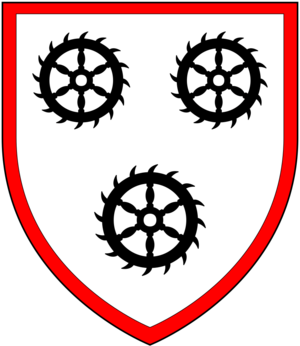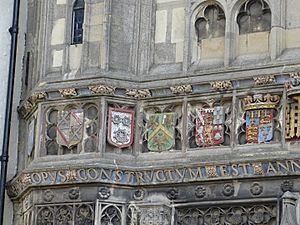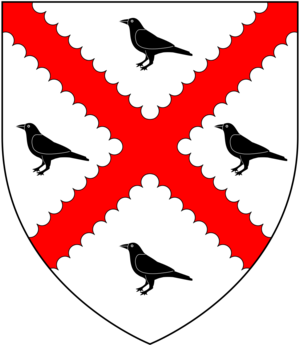John Scott (died 1485) facts for kids
Sir John Scott (born around 1423 – died 17 October 1485) was an important person from Kent, England. He lived at a place called Scot's Hall in Smeeth. He was a strong supporter of the House of York, one of the main families fighting to be King of England during his time. Sir John held many important jobs, including managing the royal household for King Edward IV and helping to protect the coast as a lieutenant for the Lord Warden of the Cinque Ports.
Contents
Sir John Scott's Family Life
John Scott was the son of William Scott (who died in 1434) and Isabel Finch. After his father passed away, his mother Isabel married Sir Gervase Clifton.
Sir John had a younger brother named William Scott (who lived from about 1428 to 1491). William married a woman named Margery and they had eight children. This William started a different part of the Scott family in Essex.
He also had a sister, Joan Scott (who died in 1507). She married twice, first to Thomas Yarde and then to Sir Henry Grey. Joan's daughter, Anne Yarde, later married Thomas Heveningham.
Sir John Scott's Career and Public Service
Sir John Scott started taking on public roles in Kent around 1450. He helped put down a rebellion led by Jack Cade that year. By 1456, he was working for King Henry VI. In 1458, he became a Justice of the Peace, which meant he helped keep law and order. He held this job until he died. In 1460, he was the High Sheriff of Kent, a very important local official.
Supporting the Yorkist Cause
A big moment in Sir John's career happened in June 1460. He, along with Sir John Fogge and Robert Horn, strongly supported the House of York. This support was very important for the York family to succeed in Kent.
When Edward IV became king (a Yorkist), Sir John Scott was rewarded. He received regular payments, was made a knight, and got important jobs. These included overseeing trade in London, working in the Common Pleas court, and helping manage the port of Sandwich. He also became a lieutenant at Dover under the powerful Earl of Warwick, known as 'the Kingmaker'. One of his most important roles was Comptroller of the Household, which meant he managed the King's personal finances and staff.
Important Land and Property
In 1462, Sir John was given control of lands that belonged to nobles who had been declared traitors to the king. This included lands from the Earl of Oxford and Baron Ros. He also gained control of Chilham Castle and other properties. In 1463, he was given more lands in Worcestershire. He was also trusted with overseeing important royal properties and marriages that came under the king's control.
In 1466, he bought the right to arrange the marriage of Sir Edward Poynings. The next year, he was given control of Sir Robert Poynings' lands in Kent.
Working for the Prince of Wales
Sir John Scott also served as the Chamberlain to Edward, Prince of Wales, who was the king's son and heir. In 1467, he became a Member of Parliament for Kent.
Diplomatic Missions
Sir John was also involved in important international affairs. In September 1467, he helped arrange the marriage of King Edward IV's sister, Margaret of York, to Charles the Bold, a powerful duke in Burgundy. Sir John went with Margaret to her wedding in Burgundy the next year. In November 1467, he helped negotiate a trade agreement with Burgundy. From May 1469 to February 1470, he was involved in trade talks with the Hanseatic League, a group of powerful trading cities, in Flanders.
In April 1470, he was appointed lieutenant of the Cinque Ports, which were important coastal towns. By March 1472, he was the Marshal of Calais, a key English stronghold in France. In 1473 and 1474, he traveled to Burgundy, Utrecht, and Bruges for more diplomatic missions.
Loyalty and Later Life
It is believed that Sir John Scott went into hiding when Henry VI briefly returned to power. However, he came back to England to fight at the Battle of Barnet in April 1471. He also helped stop Fauconberg's rebellion in May of that year.
In February 1473, Sir John and others were chosen to be tutors for King Edward IV's son, the Prince of Wales. After King Edward IV died, Sir John remained loyal to Richard III for a time.
Sir John Scott passed away on 17 October 1485. He was buried in St. Mary's church in Brabourne, as he had requested. His wife died by July 1487 and was also buried there.
An earlier Sir John Scot of Scott's Hall, who was Sir John's uncle, had also been an important figure. He was the Lieutenant of Dover Castle from 1399 until his death in 1413 and had also served as a Member of Parliament.
Sir John Scott's Marriage and Children
Sir John Scott married Agnes Beaufitz (who died in 1486 or 1487). She was the daughter of William Beaufitz. Together, they had one son and two daughters:
- Sir William Scott (who died in 1524). He married Sibyl Lewknor.
- Isabel or Elizabeth Scott (who died in 1528). Sir John Scott arranged for her to marry his ward, Sir Edward Poynings. There is a special memorial for her in St Mary's church in Brabourne.
- Margaret Scott (who died in 1514). She was the second wife of Sir Edmund Bedingfield.
There was a belief that Thomas Rotherham, who became the Archbishop of York, might have been another son of Sir John Scott and Agnes Beaufitz. However, this idea has since been shown to be incorrect.






